

DSO Kids. Beginner’s Guide To Improv – Introduction. This page describes the philosophy underlying my particular approach to learning how to play jazz.
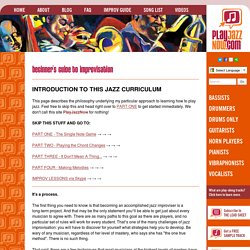
Feel free to skip this and head right over to PART ONE to get started immediately. We don't call this site PlayJazzNow for nothing! PART ONE - The Single Note Game → → → PART TWO - Playing the Chord Changes → → → PART THREE - It Don't Mean A Thing... → → → PART FOUR - Making Melodies → → → IMPROV LESSONS via Skype → → → It's a process. The first thing you need to know is that becoming an accomplished jazz improviser is a long-term project. That said, there are a few techniques that most musicians at the highest levels of mastery have used to get there.
For the purposes of this curriculum, we¹re going to assume that you already have acquired a reasonable level of competence on your chosen instrument. Why do you want to play jazz? It sounds like an idiotic question, but a clear answer will help guide your first steps on the path. So who do you want to be when you grow up (musically, that is)?
Beginning Band- Sound clips of each instrument. Concert Band Radio. Graham Nasby's Online Resources - Concert Band Instrumentation. Flute The flute has a very clear and flowing sound to it.
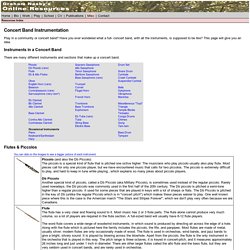
Most music has 2 or 3 flute parts. The flute alone cannot produce very much volume, so a lot of players are required in the flute section. A full-sized band will usually have 8-12 flute players. The word flute covers a wide range of woodwind instruments, in which sound is produced by directing air across the edge of a hole. Along with the flute which is pictured here the family includes the piccolo, the fife, and panpipes.
Eb Flute At one time there was another kind of flute pitched in Eb, called the Eb Flute, that was often used in bands. Fact: The flute's haunting sound has long been linked with magical properties, as in Mozart's opera, "The Magic Flute", or in the Pied-Piper legend. A Guide to Recruiting and Sustaining Enrollment for High School Music Programs. A Guide to Recruiting and Sustaining Enrollment for High School Music Programs by Philip Dolan, Instrumental Director, Amity High School, Woodbridge, CT Are you trying to increase enrollment in your music program?
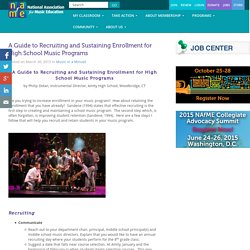
How about retaining the enrollment that you have already? Sandene (1994) states that effective recruiting is the first step in creating and maintaining a school music program. The second step which, is often forgotten, is improving student retention (Sandene, 1994). Recruiting CommunicateReach out to your department chair, principal, middle school principal(s) and middle school music directors.
Example: The Amity Jazz Band, Chamber Singers, and Strings Ensemble are allotted one hour at each school. OrganizeOnce you get everyone on board with your plan, decide on fun and entertaining music for the ensemble you plan to bring. **I remember being in 8th grade and watching the high school band and drum line perform. Retention. Vic Firth Presents: Percussion 101. The series covers instrument characteristics, maintenance routines, tuning, mallet selection and general playing techniques on the most common instruments as well as marching percussion.
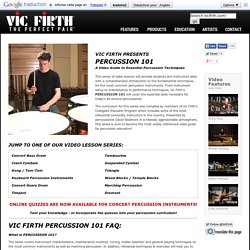
In addition, rehearsal techniques & exercises will help you to develop a great all around percussion program. This project was originally developed for use in the college percussion methods class – to serve as instruction for non-percussionists who will be charged with teaching percussion in the schools. It quickly developed into a resource to find quick answers to common questions after these students went in the field.
For current band directors, the "BAND DIRECTOR'S PERCUSSION SURVIVAL GUIDE" was the first implementation of this project. Type in your question, find a quick and applicable answer! After we began to see what a truly valuable resource this was, we began to integrate study guides and online tests so that percussion students could also take advantage of the information. YES! Brass Trainer. Beginning Band- School Band and Orchestra Information. NCSA: School of Music. An organized percussion section: The key to success. by John R.
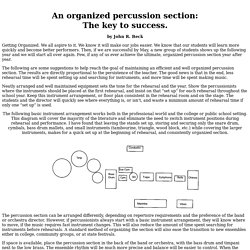
Beck Getting Organized. We all aspire to it. We know it will make our jobs easier. The following are some suggestions to help reach the goal of maintaining an efficient and well organized percussion section. Neatly arranged and well maintained equipment sets the tone for the rehearsal and the year. The following basic instrument arrangement works both in the professional world and the college or public school setting.
The percussion section can be arranged differently, depending on repertoire requirements and the preference of the band or orchestra director. If space is available, place the percussion section in the back of the band or orchestra, with the bass drum and timpani next to the low brass. Inside the Section “Bookend” your section with the bass drum and the chimes. Timpani Timpani typically play with the tubas and low brass. Bass Drum and Cymbals Bass drum and crash cymbals work as a team. Aaronmcole.com.